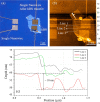Novel Mixed-Dimensional hBN-Passivated Silicon Nanowire Reconfigurable Field Effect Transistors: Fabrication and Characterization
- PMID: 37606167
- PMCID: PMC10472425
- DOI: 10.1021/acsami.3c04808
Novel Mixed-Dimensional hBN-Passivated Silicon Nanowire Reconfigurable Field Effect Transistors: Fabrication and Characterization
Abstract
This work demonstrates the novel concept of a mixed-dimensional reconfigurable field effect transistor (RFET) by combining a one-dimensional (1D) channel material such as a silicon (Si) nanowire with a two-dimensional (2D) material as a gate dielectric. An RFET is an innovative device that can be dynamically programmed to perform as either an n- or p-FET by applying appropriate gate potentials. In this work, an insulating 2D material, hexagonal boron nitride (hBN), is introduced as a gate dielectric and encapsulation layer around the nanowire in place of a thermally grown or atomic-layer-deposited oxide. hBN flake was mechanically exfoliated and transferred onto a silicon nanowire-based RFET device using the dry viscoelastic stamping transfer technique. The thickness of the hBN flakes was investigated by atomic force microscopy and transmission electron microscopy. The ambipolar transfer characteristics of the Si-hBN RFETs with different gating architectures showed a significant improvement in the device's electrical parameters due to the encapsulation and passivation of the nanowire with the hBN flake. Both n- and p-type characteristics measured through the top gate exhibited a reduction of hysteresis by 10-20 V and an increase in the on-off ratio (ION/IOFF) by 1 order of magnitude (up to 108) compared to the values measured for unpassivated nanowire. Specifically, the hBN encapsulation provided improved electrostatic top gate coupling, which is reflected in the enhanced subthreshold swing values of the devices. For a single nanowire, an improvement up to 0.97 and 0.5 V/dec in the n- and p-conduction, respectively, is observed. Due to their dynamic switching and polarity control, RFETs boast great potential in reducing the device count, lowering power consumption, and playing a crucial role in advanced electronic circuitry. The concept of mixed-dimensional RFET could further strengthen its functionality, opening up new pathways for future electronics.
Keywords: ambipolar; flash lamp annealing; hBN encapsulation; mixed-dimensional reconfigurable FET; nickel silicide; subthreshold swing.
Conflict of interest statement
The authors declare no competing financial interest.
Figures







References
-
- Simon M.; Heinzig A.; Trommer J.; Baldauf T.; Mikolajick T.; Weber W. M. Top-down Technology for Reconfigurable Nanowire FETs with Symmetric On-Currents. IEEE Trans. Nanotechnol. 2017, 16, 812–819. 10.1109/TNANO.2017.2694969. - DOI
-
- Mikolajick T.; Galderisi G.; Rai S.; Simon M.; Böckle R.; Sistani M.; Cakirlar C.; Bhattacharjee N.; Mauersberger T.; Heinzig A.; et al. Reconfigurable Field Effect Transistors: A technology Enablers Perspective. Solid-State Electron. 2022, 194, 108381.10.1016/j.sse.2022.108381. - DOI
-
- Lin Y.-M.; Appenzeller J.; Knoch J.; Avouris P. High-Performance Carbon Nanotube Field-Effect Transistor with Tunable Polarities. IEEE Trans. Nanotechnol. 2005, 4, 481–489. 10.1109/TNANO.2005.851427. - DOI
-
- Lin Y.-M.; Chiu H.-Y.; Jenkins K. A.; Farmer D. B.; Avouris P.; Valdes-Garcia A. Dual-Gate Graphene FETs with f_{T} of 50 GHz. IEEE Electron Device Lett. 2010, 31, 68–70. 10.1109/led.2009.2034876. - DOI
LinkOut - more resources
Full Text Sources
Research Materials
Miscellaneous

